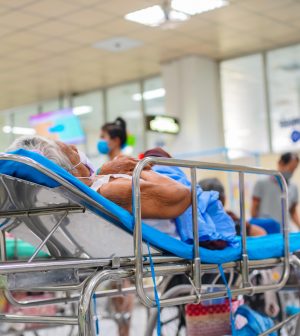- Skip Storing This Everyday Product in the Fridge Door
- Green Tea + B3 Pairing May Boost Brain Health
- Navigating Your Midlife Crisis: Embracing New Possibilities
- City Raccoons Showing Signs of Domestication
- Mapping the Exposome: Science Broadens Focus to Environmental Disease Triggers
- One Week Less on Social Media Linked to Better Mental Health
- Your Brain Changes in Stages as You Age, Study Finds
- Some Suicide Victims Show No Typical Warning Signs, Study Finds
- ByHeart Formula Faces Lawsuits After Babies Sickened With Botulism
- Switch to Vegan Diet Could Cut Your Greenhouse Gas Emissions in Half
Diabetes Care Falters for Rural Patients: Study

If you live in a small town and have diabetes, you’re more likely to suffer serious setbacks than your cousin in the big city.
New research shows that people in towns with fewer than 50,000 people have a significantly higher risk of diabetes-related complications, including heart attack and kidney disease.
“Those who live in rural areas have a greater risk of experiencing eight out of the 11 complications that we measured compared to those living in cities,” said corresponding study author Dr. Rozalina McCoy, an associate professor at the University of Maryland School of Medicine.
“They were 15 percent more likely to have dangerously low blood sugar levels, which clearly indicates that their diabetes is not being managed properly,” she added in a university news release.
Her team analyzed nationwide health insurance data from nearly 3 million adults with diabetes over a decade ending in 2021.
Those living in small towns were 10% more likely to experience a heart attack, 5% more likely to have heart failure and about 4% more likely to have end-stage kidney disease than their counterparts in larger towns and cities, the study found.
About 14% of those in the study lived in small towns, while 83% lived in cities. Another 3% lived in remote areas with fewer than 2,500 people.
The study found that people living in those remote areas were less likely to be diagnosed with some diabetes complications. They were 15% less likely to have dangerously high blood sugar and 6% less likely to have heart failure than those in small towns.
But researchers emphasized that doesn’t mean they’re OK. Since the study relied on insurance data to identify complications, if people weren’t able to get medical care, researchers wouldn’t know about it. McCoy said this underscores barriers to care in remote areas: patients are likely having serious problems but can’t get to the E.R. to have them diagnosed and treated.
The study controlled for age, sex, health insurance type, diabetes type, medication use and chronic health conditions.
“People living outside of city areas are less likely to receive care from diabetes specialists, to receive diabetes self-management education, and to be monitored for diabetes complications,” said study co-author Dr. Esa Davis, senior associate dean for population and community medicine at Maryland. “Our research builds on this foundational evidence to demonstrate a possible impact that these differences have on preventable diabetes complications.”
Dr. Mark Gladwin, vice president for medical affairs at Maryland, reacted to the findings.
“While the relative risk increases in diabetes complications were modest for those who dwell in rural areas, they can add up to a huge health burden since more than 5 million Americans who have diabetes live in small towns,” he said. “There is a pressing need to enhance physician and medical provider services and hospital services for those living in rural communities.”
The University of Maryland is planning a new program to bring its medical students to the state’s Eastern Shore to help close the gap, Gladwin noted.
The findings were published recently in the journal Diabetes Care.
More information
SOURCE: University of Maryland School of Medicine, news release, March 8, 2024
Source: HealthDay
Copyright © 2025 HealthDay. All rights reserved.










